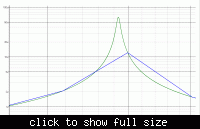koushikr_in
Member level 2
Hi,
I simulated a simple RLC parallel circuit using LTspice. The circuit diagram and results are attached. A current source (1 nA) connected across parallel RLC. In the AC response, I expect all the current (1nA) to flow through resistor (63 kohms). But I find only 180 pA flowing through the resistor at resonance. Why is this so?
Thanks
Koushik
I simulated a simple RLC parallel circuit using LTspice. The circuit diagram and results are attached. A current source (1 nA) connected across parallel RLC. In the AC response, I expect all the current (1nA) to flow through resistor (63 kohms). But I find only 180 pA flowing through the resistor at resonance. Why is this so?
Thanks
Koushik






